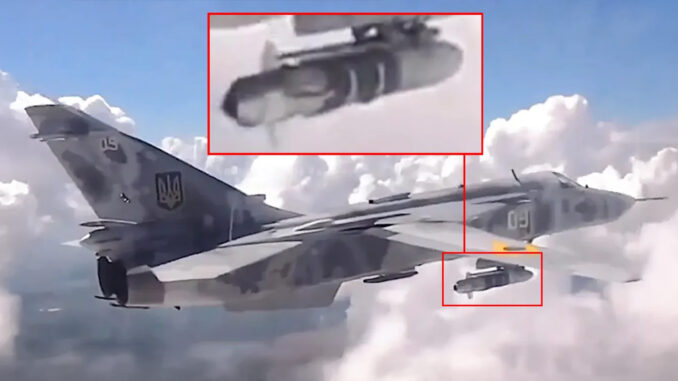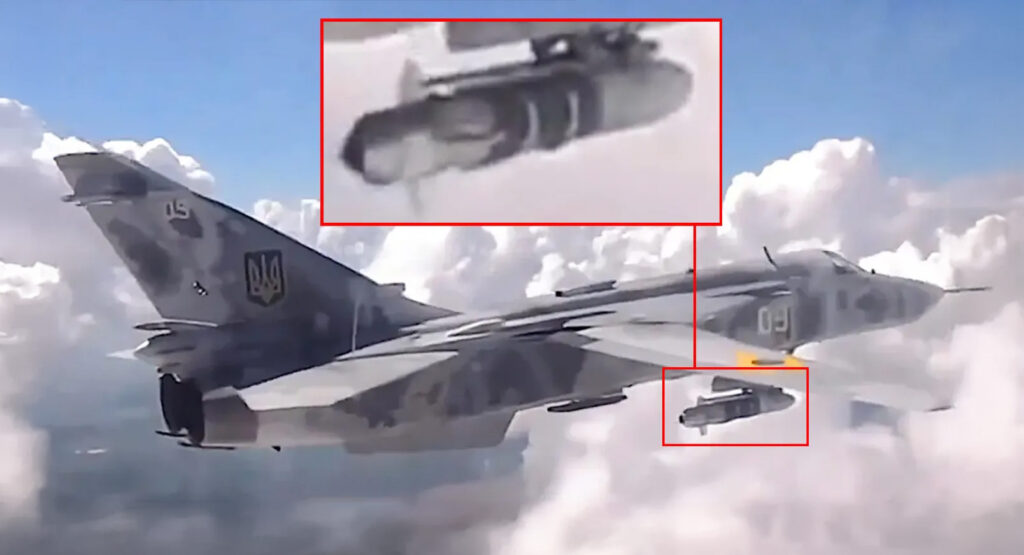
Discover the specifications and strategic importance of Ukraine’s new guided munition, in response to the need for precision armaments.
A Ukrainian Su-24 has been spotted carrying a new guided munition, essential in the face of growing needs for long-range precision munitions. With dense enemy air defence systems, the need for munitions capable of striking at a distance is critical. This munition could be a kit for converting a conventional bomb into a precision weapon, similar to those already supplied by the West. Its domestic development would give Ukraine a crucial strategic advantage by limiting its dependence on foreign supplies.
Critical need for long-range ammunition
Ukraine is facing a strong demand for precision ammunition that can be launched from a distance. This need stems mainly from Russia’s extremely dense air defences, which limit the Ukrainian air force’s ability to get close enough to targets while minimising the risks. Remote-guided munitions, known as stand-off munitions, are therefore of vital importance.
The development of such munitions is not unique to Ukraine. For example, the United States has deployed its AGM-158 JASSM, a long-range cruise missile that enables aircraft to stay clear of high-density air defence zones. The development costs of such munitions vary widely, but a missile like the JASSM can cost between €800,000 and €1 million** depending on the version.
For Ukraine, developing a similar capability in-house, without relying on foreign supplies, would reduce procurement times and avoid the restrictions on use imposed by Western suppliers. This ammunition could therefore play a strategic role in future Ukrainian air operations, particularly in heavily defended regions such as Crimea and eastern Ukraine.
Promising flight test
The video released showing a Ukrainian Su-24 equipped with this new munition is significant for several reasons. Firstly, the observed configuration shows a device divided into three distinct sections, which generally corresponds to a guidance kit for converting a conventional bomb into a precision weapon. It is important to note that such kits, such as the JDAM-ER (Joint Direct Attack Munition – Extended Range), are already used by Ukraine, but are supplied by third countries such as the United States and France.
The addition of such domestic ammunition to the Ukrainian arsenal could greatly increase the flexibility of military operations. Indeed, the possibility of producing these weapons locally would make it possible to free oneself from the restrictions on use imposed by the supplier countries. This could prove crucial for long-range strikes in enemy territory, where precision is essential to limit collateral damage.
The cost of producing a JDAM-ER conversion kit varies between €25,000 and €50,000 per unit, depending on the range and additional features such as thrusters. If Ukraine manages to produce such systems at a competitive cost, it would be a major boost to its military capabilities.

Technical characteristics of the ammunition
According to the images available, the ammunition consists of three distinct parts: the nose, the central body and the tail. This architecture is typical of modern guided munitions, where each part plays a specific role. The nose generally houses the guidance system, the central body contains the explosive components, and the tail, with its fins, provides stabilisation and directional control.
One remarkable technical detail is the presence of a cruciform structure at the rear of the munition, suggesting the existence of a propulsion system. This could indicate a solid or air propulsion motor, potentially increasing the weapon’s range. In comparison, JDAM-ER bombs with deployable wings can reach targets over 70 km when dropped at high altitude.
This type of guided ammunition allows greater flexibility in low-altitude missions, a common practice among Ukrainian pilots to avoid enemy air defences. However, at low altitude, the range of non-propelled munitions is limited, hence the need to add a propulsion system to increase their effectiveness.
Comparison with Western systems
Ukraine has already received precision guided munitions such as the JDAM-ER from the United States and the SCALP-EG from France. These weapons are highly accurate and have a long range, but they are in limited supply. In fact, stocks of ammunition such as the SCALP-EG were already depleted before they were sent to Ukraine, making their supply irregular.
By producing an equivalent munition locally, Ukraine could gain a major strategic advantage. The question of ammunition supplies has become a critical issue for the Ukrainian armed forces, which are heavily dependent on Western stocks. Recent reports indicate that even countries such as the USA are considering developing new low-cost ammunition to meet Ukraine’s growing needs.
Ammunition systems such as the JDAM-ER, which can be fitted with deployable wings, extend the range of bombs by up to 80 km. This type of technology is essential for hitting well-defended targets while maintaining a safe distance. However, these munitions may not be adapted to Ukraine’s specific needs, notably because of the constraints imposed by their international suppliers.
Strategic consequences and future development
The development of a national guided munition is a significant step forward for Ukraine. Not only does it reduce its dependence on foreign munitions, but it also offers greater operational flexibility. The ability to produce and deploy munitions without foreign restrictions would allow Ukrainian forces to adapt their tactics more freely.
Ukraine’s air defence strategy relies heavily on long-range strikes against strategic targets in the Crimea and other occupied areas. The use of kamikaze drones and long-range munitions has already proved effective in these regions. By developing munitions with similar or greater capabilities, Ukraine could reinforce this strategy and increase the pressure on opposing military infrastructures.
From a wider perspective, the adoption of these technologies could also influence the defence policies of Ukraine’s Western allies, who are seeking to limit the escalation of the conflict by imposing conditions on the use of their weapons.
War Wings Daily is an independant magazine.